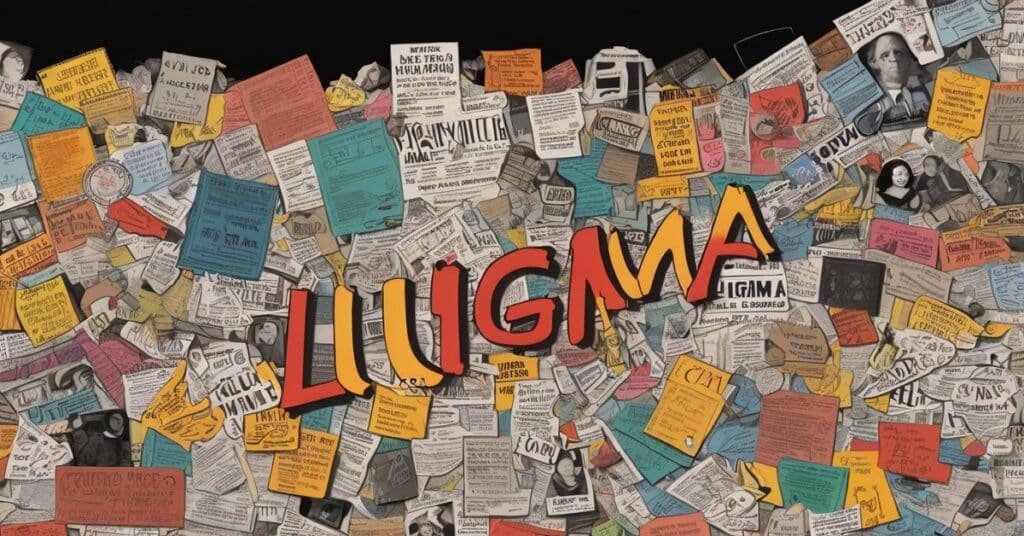In July 2018, millions of internet users found themselves asking a simple question that would make them the unwitting victims of one of the most successful pranks in gaming history. The question was innocent enough: “What’s ligma?” The answer, however, revealed the surprising power of collective digital deception and transformed a crude joke into a cultural phenomenon that continues to influence internet humor today.
Understanding the ligma meaning requires more than recognizing it as a simple prank. This seemingly harmless meme demonstrates how internet culture creates sophisticated social experiments, builds digital communities, and manipulates our cognitive biases in ways that reveal fundamental truths about human nature online.

The Anatomy of a Viral Deception: How Ligma Was Born
The Perfect Storm: July 2018
The ligma meme originated from a death hoax orchestrated by Instagram user “ninja_hater” that falsely claimed popular Fortnite streamer Ninja had died from a fictional disease called “ligma.” This wasn’t random timing. The hoax emerged during Fortnite’s peak popularity, when Ninja commanded audiences of hundreds of thousands of viewers and had become a household name even outside gaming circles.
On July 17, 2018, the hoax gained significant traction when Ninja stopped streaming, apparently because he was on a flight, leading many to believe the false reports of his death. The timing created a perfect information vacuum that the hoax quickly filled.
The spread pattern reveals the sophisticated nature of modern internet pranks:
Phase 1: Initial Seeding
- Instagram user creates fake news posts
- Twitter accounts begin sharing “breaking news”
- Discord servers and Reddit threads discuss the “tragedy”
Phase 2: Viral Amplification
- Concerned fans frantically search for information
- News aggregators begin picking up the story
- Social media algorithms boost engagement due to high interaction rates
Phase 3: The Revelation
- Victims ask “What’s ligma?” in comments and posts
- Pranksters respond with “ligma balls” (lick my balls)
- The crude punchline is revealed, completing the setup
Linguistic Engineering: The Science Behind the Setup
The ligma meaning’s effectiveness lies in its carefully constructed phonetic properties. While “ligma” has no meaning and is not a real word in any language, it was specifically designed to sound legitimate.
Researchers in memetic psychology have identified several key factors that made “ligma” particularly effective:
Phonetic Credibility
- The suffix “-ma” mimics medical terminology (trauma, asthma, carcinoma)
- The hard “g” sound creates gravity and seriousness
- The two-syllable structure matches many real disease names
Cognitive Processing Triggers
- Unfamiliar but structured enough to seem plausible
- Creates what psychologists call “tip-of-the-tongue” phenomenon
- Exploits our tendency to seek closure on incomplete information
Social Proof Mechanics
- Multiple sources discussing the same “condition”
- Authority figures (streamers, content creators) seemingly affected
- Time pressure created by “breaking news” context
The success rate was remarkable. Twitter became ground zero for the joke’s viral spread, with countless users innocently asking about the fictional disease.

The Meme Family Tree: Evolution and Variations
Core Variants and Their Psychological Mechanics
The ligma phenomenon spawned an entire ecosystem of similar pranks, each exploiting different cognitive vulnerabilities:
Sugma (Setup: “Sugma disease is spreading”)
- Response: “Sugma balls”
- Success factor: Medical urgency implied by “spreading”
- Demographic appeal: Particularly effective among younger users
Bofa (Setup: “Have you heard about Bofa?”)
- Response: “Bofa deez nuts”
- This variant has historical significance, as Brady Olson, who made a satirical 2016 presidential run under the pseudonym “Deez Nuts,” confirmed to Rolling Stone that he chose it based on the bofa meme.
- Success factor: Casual conversation starter format
Sugondese (Setup: “My friend is Sugondese”)
- Response: “Suck on deez nuts”
- Success factor: Exploits curiosity about ethnicities/nationalities
- Geographic targeting: Works particularly well in diverse communities
The hoax also spawned jokes about the fictional Indonesian city Grabahan (“grab a hand”) and additional fictional diseases Sugma (“suck my”) and Bofa (“both of”).
Platform-Specific Evolution
Each social media platform developed unique ligma variations adapted to their user behaviors:
Twitter Adaptations
- Character limit forced concise setups
- Hashtag integration (#RIPNinja, #LigmaAwareness)
- Quote tweet chains amplified the prank
Instagram Stories
- Visual elements added credibility (fake news screenshots)
- Time-sensitive nature increased urgency
- Story polls (“Have you heard of ligma?”) gathered victims
TikTok Innovations
- Video format allowed for elaborate setup scenarios
- Reaction videos became secondary content streams
- Audio trends spread the pronunciation globally
Discord Communities
- Server-specific inside jokes developed
- Voice chat allowed for real-time pranking
- Bot integrations automated responses

The Psychology of Digital Pranking: Why We Fall for It
Cognitive Vulnerabilities in Online Spaces
Understanding why the ligma meaning became so widespread requires examining how our brains process information in digital environments. Internet memes are units of information that embed cultural values and norms of said group, and research shows they have significant impact on collective identity within online communities.
Information Processing Shortcuts
Our brains evolved to make quick decisions with limited information. In online spaces, this creates specific vulnerabilities:
- Heuristic Processing: We rely on mental shortcuts to evaluate information rapidly
- Authority Bias: Information shared by trusted accounts gains automatic credibility
- Confirmation Seeking: We’re more likely to believe information that fits existing patterns
- Social Validation: Seeing others discuss a topic increases our belief in its legitimacy
Trust Mechanisms in Digital Spaces
Online, we develop different trust patterns than in face-to-face interactions:
- Parasocial Relationships: We feel genuine concern for content creators we follow
- Network Effects: Information shared by multiple sources seems more credible
- Algorithmic Amplification: Platform algorithms boost engaging content, regardless of accuracy
- Context Collapse: Jokes and serious information blend together in feeds
The Victim-Perpetrator Cycle
Research demonstrates that when a culture faces a problem, memes become a decisive means to reinterpret the situation. The ligma phenomenon created a unique psychological cycle:
Stage 1: Victimization
- Initial embarrassment and confusion
- Feeling of being “tricked” or “had”
- Brief period of frustration or annoyance
Stage 2: Understanding
- Recognition of the prank mechanism
- Appreciation for the cleverness of the setup
- Shift from victim to observer perspective
Stage 3: Participation
- Active sharing of the meme with others
- Creation of new variations or contexts
- Integration into personal humor repertoire
Stage 4: Community Integration
- Becoming part of the “in-group” that understands the joke
- Using knowledge as social currency
- Teaching others about meme culture
This cycle explains why ligma variants continue to circulate years after the original hoax. Each new victim potentially becomes an advocate, creating a self-sustaining cultural transmission system.
Cultural Impact Analysis: Beyond the Joke
Gaming Community Integration
The ligma meaning’s connection to gaming culture runs deeper than its Ninja origins. Gaming communities have always been early adopters of internet humor, creating a perfect testing ground for new meme formats.
Streamer Ecosystem Response
The reaction among content creators varied significantly:
- Embracers: Some streamers incorporated ligma jokes into their content, recognizing the entertainment value
- Rejecters: Others, like Ninja himself, found the constant repetition annoying and began banning users
- Adapters: Many used the phenomenon as teachable moments about internet literacy
Ninja’s response was particularly telling – he became so annoyed with the constant ligma references that he began banning people from his chat for 24 hours, and when that didn’t work, he implemented permanent bans on his YouTube channel.
Platform Policy Challenges
The ligma phenomenon highlighted important questions about content moderation:
- False Information vs. Humor: How do platforms distinguish between harmful misinformation and harmless pranks?
- Celebrity Protection: What responsibility do platforms have to protect public figures from hoaxes?
- Community Standards: Where do crude jokes cross the line into harassment?
Mainstream Media Infiltration
The ligma meaning transcended internet culture when traditional media outlets began covering the story. Several news organizations initially reported on Ninja’s “death” before realizing they had fallen victim to the hoax themselves.
This media infiltration revealed several concerning trends:
Verification Failures
- Rush to publish breaking news without proper fact-checking
- Over-reliance on social media as primary sources
- Limited understanding of internet culture among traditional journalists
Digital Native vs. Traditional Media
- Younger audiences immediately recognized the hoax
- Older demographics more likely to believe initial reports
- Generation gap in meme literacy became apparent
Corporate Learning Curve
- Brands initially confused about whether to acknowledge the meme
- Some companies successfully leveraged the humor
- Others faced backlash for inappropriate responses
Linguistic Deconstruction: The Mechanics of Meme Language
Phonological Analysis
‘Meme’, originally defined as cultural units that spread from person to person through imitation, is now commonly used to describe content like jokes, images, or quotes that are shared online with other users. The ligma phenomenon demonstrates how modern memes exploit linguistic patterns for maximum viral potential.
Sound Pattern Recognition
The effectiveness of “ligma” lies in its phonetic construction:
- Consonant Clusters: The “gm” combination is uncommon in English, making it memorable
- Vowel Patterns: The “i-a” pattern mimics familiar words (sigma, dogma, stigma)
- Syllable Stress: Natural emphasis falls on the first syllable, aiding recall
- Rhyme Potential: Easy to create variations with similar sound patterns
Cross-Linguistic Appeal
Surprisingly, ligma variants have appeared in multiple languages:
- Spanish: “Ligma” pronunciation remains consistent
- French: “Sugma” adaptation maintains phonetic integrity
- German: Compound word variations follow language rules
- Japanese: Katakana rendering preserves original sound
Semantic Manipulation Techniques
The ligma meaning demonstrates sophisticated semantic manipulation:
False Etymology Creation
- Memes develop fake backstories and histories
- Users create elaborate explanations for fictional terms
- Wikipedia-style “articles” lend false credibility
- Medical terminology borrowing increases perceived legitimacy
Authority Mimicry
- Health organizations’ communication styles are copied
- Scientific language patterns are appropriated
- Expert opinions are fabricated or misattributed
- Official-looking graphics and infographics are created
Context Switching
- Begins in serious, medical context
- Transitions to crude humor revelation
- Creates cognitive dissonance for maximum impact
- Exploits expectations about information sources
The Dark Side: When Memes Become Misinformation
Blurred Lines: Humor vs. Deception
While the ligma meaning started as harmless entertainment, it raises important questions about the ethics of digital deception. Defined as cultural units that spread from person to person, memes in digital culture have become more complex than simple humor.
The Misinformation Pipeline
The ligma phenomenon demonstrates how quickly false information can spread:
- Initial Deception: Fake news about celebrity death
- Amplification: Social media algorithms boost engagement
- Legitimization: Multiple sources report the same story
- Revelation: Truth emerges, but damage may be done
Psychological Impact on Victims
Beyond embarrassment, falling for ligma-style pranks can have lasting effects:
- Trust Erosion: Increased skepticism toward online information
- Social Anxiety: Fear of being “fooled” again in public forums
- Information Avoidance: Some users become overly cautious about sharing news
- Digital Literacy Pressure: Feeling required to understand every internet reference
Educational Opportunities
However, the ligma phenomenon also creates valuable teaching moments:
Critical Thinking Development
- Demonstrates importance of source verification
- Shows how emotional responses can override logical analysis
- Illustrates the speed of misinformation spread
- Provides concrete example of cognitive bias exploitation
Digital Citizenship Skills
- Understanding consent in online interactions
- Recognizing the impact of “harmless” pranks
- Learning appropriate contexts for different types of humor
- Developing empathy for prank victims
Media Literacy Applications
- Identifying reliable vs. unreliable sources
- Understanding how algorithms amplify certain content
- Recognizing manipulative content design
- Learning to pause before sharing unverified information
Modern Evolution: Where Ligma Stands Today
Current Usage Patterns (2024-2025)
Internet memes created by modifying existing formats represent a new phenomenon in human public life and new type of communication, with their distinctive feature being the surprise and laughter they cause. Today’s ligma usage has evolved significantly from its 2018 origins.
Platform Analytics Overview
Current ligma mentions across major platforms show interesting patterns:
- TikTok: Primarily used in “gen Z explains to millennials” content
- Twitter/X: Often referenced in discussions about internet history
- Reddit: Appears in “veteran internet user” contexts
- Discord: Still actively used for pranking newcomers
- Instagram: Mostly nostalgic references and throwback content
Demographic Shifts
The user base has changed dramatically:
- Original Adopters (2018): Now use it ironically or nostalgically
- Current Teens: Often unaware of the original context
- Adult Newcomers: Discover it through family members or coworkers
- Academic Researchers: Study it as a case example of viral culture
Mutation Tracking
New variations continue to emerge:
- Meta-Ligma: Jokes about ligma jokes themselves
- Corporate Ligma: Brands attempting to use the format
- Educational Ligma: Teachers using it to engage students
- Reverse Ligma: Victims who preemptively reveal the punchline
Legacy and Influence
Academic Recognition
Universities now study the ligma phenomenon in multiple disciplines:
- Communication Studies: Viral information spread patterns
- Psychology: Cognitive bias and social influence research
- Linguistics: Language evolution in digital environments
- Sociology: Community formation around shared knowledge
Cultural Preservation Efforts
Several initiatives document early internet history:
- Internet Archive: Preserving original posts and reactions
- Academic Papers: Formal analysis of the phenomenon
- Documentary Projects: Interviews with key participants
- Museum Exhibits: Digital culture preservation efforts
Influence on Subsequent Memes
Ligma established patterns that continue to influence internet humor:
- Setup-Punchline Structure: Clear question-answer format
- Celebrity Integration: Using public figures for amplification
- False Urgency: Creating time pressure for maximum effect
- Community Participation: Encouraging others to “get in on” the joke
Practical Guide: Navigating Ligma Culture
For Newcomers
Recognition Strategies
Learning to spot ligma-style setups protects against embarrassment:
- Unfamiliar Terms: Be skeptical of new “diseases” or “conditions”
- Urgent Tone: Question breaking news from unofficial sources
- Celebrity Focus: Verify celebrity-related news through official channels
- Too Good to Share: If it seems designed to provoke a specific response, pause
Response Options
If you encounter a ligma-style setup:
- Acknowledge Awareness: “Nice try, but I know what ligma is”
- Reverse the Joke: “Ligma what?” (showing you’re in on it)
- Educational Response: “That’s the old ligma joke from 2018”
- Graceful Exit: Simply don’t engage with suspicious prompts
Participation Ethics
When considering using ligma-style humor:
- Know Your Audience: Ensure recipients will find it amusing
- Avoid Professional Settings: Keep crude humor out of work contexts
- Consider Timing: Don’t prank people during stressful periods
- Respect Boundaries: Stop if someone asks you to
For Educators and Parents
Age-Appropriate Discussions
Addressing ligma meaning with younger audiences:
- Elementary Age: Focus on not believing everything online
- Middle School: Discuss the difference between jokes and lies
- High School: Examine the psychology of viral misinformation
- College: Analyze the cultural significance of internet phenomena
Teaching Moments
Using ligma to discuss broader concepts:
- Source Verification: How to check if information is real
- Emotional Manipulation: How pranks exploit our feelings
- Community Dynamics: How shared knowledge builds groups
- Digital Empathy: Understanding how online actions affect others
Setting Boundaries
Establishing appropriate limits:
- Home Rules: Family guidelines about internet humor
- School Policies: Clear expectations for classroom behavior
- Online Conduct: Respectful participation in digital spaces
- Consequence Planning: What happens when lines are crossed
The Lasting Impact of Digital Deception
Cultural Significance Recap
The ligma meaning extends far beyond a simple internet prank. It represents a pivotal moment in digital culture where millions of people simultaneously experienced the same joke, creating a shared reference point that continues to influence online communication.
Sociological Implications
Ligma revealed fundamental truths about human nature in digital spaces:
- Collective Vulnerability: Even tech-savvy users can be fooled
- Community Formation: Shared experiences create lasting bonds
- Information Hierarchy: Some knowledge becomes social currency
- Cultural Evolution: Internet culture develops its own traditions
Linguistic Evolution
The phenomenon demonstrates how internet culture shapes language:
- Neologism Creation: New words enter common usage rapidly
- Pronunciation Standardization: Global consensus on unfamiliar terms
- Context Development: Words gain specific cultural meanings
- Intergenerational Transmission: Memes become cultural knowledge
Looking Forward
Prediction Framework
Understanding ligma helps identify potential future viral phenomena:
- Phonetic Appeal: Sounds that suggest legitimacy
- Emotional Hooks: Content that triggers strong responses
- Community Involvement: Jokes that require participation
- Timing Factors: Cultural moments ripe for exploitation
Evolution Patterns
Meme formats typically follow predictable lifecycle stages:
- Innovation: New format emerges
- Rapid Growth: Viral adoption across platforms
- Peak Saturation: Maximum cultural penetration
- Decline: Overuse leads to decreased effectiveness
- Legacy Integration: Becomes part of cultural knowledge base
The ligma phenomenon has completed this cycle, transitioning from active meme to cultural artifact. Its lasting impact lies not in continued use, but in what it taught us about digital communication, human psychology, and the power of collective online experiences.
The Surprising Depth of Simple Humor
Perhaps the most remarkable aspect of understanding ligma meaning is recognizing how much complexity underlies seemingly simple internet jokes. What began as a crude prank evolved into a comprehensive case study of digital culture, revealing insights about human behavior, information spread, community formation, and linguistic evolution.
In our interconnected world, even the simplest shared experiences can become significant cultural moments. The ligma phenomenon reminds us that internet culture, while often dismissed as trivial, represents genuine human creativity, community building, and cultural evolution happening at unprecedented speed and scale.
As we continue to navigate an increasingly digital world, understanding phenomena like ligma becomes more than academic curiosity it becomes essential digital literacy, helping us participate more thoughtfully and effectively in the online communities that increasingly shape our daily lives.
For more visit: https://prayersland.com/

Noah James is the author behind PrayersLand, a blog dedicated to inspiring faith, hope, and spiritual growth. With a deep passion for prayer and devotion, he shares heartfelt reflections, powerful prayers, and uplifting insights to strengthen believers on their spiritual journey. His writings aim to bring comfort, wisdom, and divine connection.

